
The Adoration of the Magi, by Bartolomé Esteban Murillo…
* * * *
The 12 Days of Christmas officially end on January 6. But in another sense you could say the extended Christmas holiday season doesn’t end – this year – until January 11.
To the Church of England – and others – that Feast Day is known as Plough Monday. (As noted in the post of the same name, which also noted the preceding “Plough Sunday.”) But the key to all these Feast Days is January 6, familiar to most church-goers as the Epiphany.
The Epiphany is the “Christian feast day that celebrates the revelation of God the Son as human in Jesus Christ.” Yet another name for January 6 is Three Kings’ Day:
The observance [of Epiphany] was a general celebration of the manifestation of the Incarnation of Jesus Christ. It included the commemoration of his birth; the visit of the Magi [and] all of Jesus’ childhood events, up to and including his baptism in the Jordan by John the Baptist; and even the miracle at the wedding at Cana in Galilee. [E.A.]
So January 6 is celebrated for a number of reasons, including but not limited to the Epiphany. That’s another way of saying the day also commemorates – inter alia – the circumcision of Jesus, as noted below. But first some more on the Magi (“Three Kings”).
In its original sense – circa 600 A.D. – Magi meant “followers of Zoroastrianism or Zoroaster.”
But starting about 1200 A.D., the term became more commonly used “in reference to the “μάγοι” [“magoi”] from the east who visit Jesus.” (As noted in Matthew 2, verses 1-12. And incidentally, these “Three Wise Men” were mentioned only in Matthew’s Gospel.)
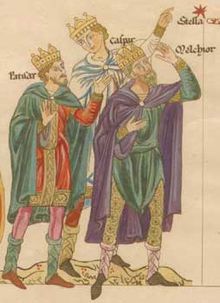
The consensus – that there were three “kings” – seems to have arisen because they brought three gifts: Gold, frankincense, and myrrh. And while a literal view of the Three Wise Men seems to indicate that they arrived at the manger-scene shortly after the birth of Jesus, the truth of the matter seems a bit harder to pin down.
For one thing the Bible doesn’t name these three kings. (Shown at left.)
But later tradition and legend did provide a number of names. The most common names given the three are: Melchior, from Persia; Caspar, from India; and Balthazar, from Babylon. (Which could have presented some logistical difficulties; for example, in their getting together to start the trip.) And as to when they actually visited Jesus:
The Bible specifies no interval between the birth and the visit [by the Magi, but] artistic depictions … encourage the popular assumption that the visit took place the same winter as the birth… [L]ater traditions varied, with the visit [said to occur] up to two winters later. This maximum interval explained Herod’s command at Matthew 2:16–18 that the Massacre of the Innocents included boys up to two years old. (E.A.)
Thus adding some more confusion to these after-Christmas holidays.
One thing we do know – from the Revised Common Lectionary – is the list of Bible readings for the Epiphany. It includes Isaiah 60:1-6, Psalm 72, Ephesians 3:1-12, and Matthew 2:1-12.
Matthew’s Gospel begins, “In the time of King Herod, after Jesus was born in Bethlehem of Judea, wise men from the East came to Jerusalem, asking, ‘Where is the child who has been born king of the Jews? For we observed his star at its rising, and have come to pay him homage.'”
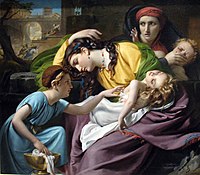 Unfortunately, this news scared the stuffing out of Herod the Great. (At the time the “Roman client king of Judea.”) That kingly fright led to another Feast Day – December 28 – remembering the Slaughter of the Holy Innocents. See also the Wikipedia article, which included the image at right:
Unfortunately, this news scared the stuffing out of Herod the Great. (At the time the “Roman client king of Judea.”) That kingly fright led to another Feast Day – December 28 – remembering the Slaughter of the Holy Innocents. See also the Wikipedia article, which included the image at right:
Herod ordered the execution of all young male children in the vicinity of Bethlehem, so as to avoid the loss of his throne to a newborn King of the Jews whose birth had been announced to him by the Magi. In typical Matthean style, it is understood as the fulfillment of an Old Testament prophecy [in] Jeremiah 31:15: [“Rachel weeping for her children…”]
On a more cheerful note – and also getting back to the Three Kings:
We’re familiar with those three wise men today largely thanks to a Christmas carol, “We Three Kings of Orient Are.” (For a live “old-timey” version see the Kings College Choir, Cambridge.)
That carol – a “song of praise or joy, especially for Christmas” – was written in 1857 by John Henry Hopkins, Jr. (At the time he was an Episcopal deacon serving as the musical director for the General Theological Seminary in New York City.) But as noted in We Three Kings – Wikipedia, solid facts about the three are hard to pin down: “Though the event is recounted in the Gospel of Matthew, there are no further details given with regards to their names, the number of Magi that were present or whether they were even royal.”
On that note – and continuing the theme of confusion in these recent “Christmasy” holidays:
We may know January 1st as National Hangover Day. But in and to the universal church, it’s better known as the Feast of the Holy Name of Jesus. (See also CATHOLIC ENCYCLOPEDIA: Feast of the Holy Name.) And for the full “rest of the story,” see Lectionary – Satucket.
“Satucket” has full sets of Bible readings for the Daily Office. (As noted below, that’s where the “DOR” in Dorscribe” came from.) And a fuller, more earthy explanation:
On January 1st, we celebrate the Circumcision of Christ. Since we are more squeamish than our ancestors [ – “easily shocked, offended, or disgusted by unpleasant things” – ], modern calendars often list it as the feast of the Holy Name of Jesus, but the other emphasis is the older. Every Jewish boy was circumcised (and formally named) on the eighth day of his life, and so, one week after Christmas, we celebrate the occasion when Our Lord first shed His blood for us. It is a fit close for a week of martyrs, and reminds us that to suffer for Christ is to suffer with Him. (E.A.)
(See the Holy Name link.) But one problem leading to confusion is that January 1 is only seven days after December 25. That problem could be solved by saying Jesus was actually born on Christmas Eve – December 24 – but the confusion wouldn’t end there:
In the Latin Rite Catholic Church it [ – the Feast of the Holy Name – ] is observed as an optional memorial on January 3 by Catholics following the present General Roman Calendar. Franciscans, Carmelites, and Augustinians kept the feast on January 14; Dominicans on January 15[, and] in some localities the date was January 8, in others January 31, in some localities in Great Britain on August 7.*
For one sure answer we can look to Luke 2:21: “On the eighth day, when it was time to circumcise the child, he was named Jesus, the name the angel had given him before he was conceived.” That was in accordance with Genesis 17:12: “For the generations to come every male among you who is eight days old must be circumcised.”
 The reason for such a practice was given in Genesis 17:11. There God told Abraham (nee “Abram”) – and those who would follow him – “You are to undergo circumcision, and it will be the sign of the covenant between me and you.” And finally, this was consistent with what happened to John the Baptist, in Luke 1:59: “On the eighth day they came to circumcise the child, and they were going to name him after his father Zechariah.” (But his mother said, “No! His name is John!“)
The reason for such a practice was given in Genesis 17:11. There God told Abraham (nee “Abram”) – and those who would follow him – “You are to undergo circumcision, and it will be the sign of the covenant between me and you.” And finally, this was consistent with what happened to John the Baptist, in Luke 1:59: “On the eighth day they came to circumcise the child, and they were going to name him after his father Zechariah.” (But his mother said, “No! His name is John!“)
And now – in closing – a few words about circumcision. It’s “the world’s oldest planned surgical procedure,” thought to be “over 15,000 years old, pre-dating recorded history.” And aside from showing one’s “covenant with God,” some historians suggest it began as a way to mark slaves. (Perhaps with an instrument like that at right.)
But the consensus seems to be that it served as a “mark of distinction:”
The earliest historical record of circumcision comes from Egypt … dating to about 2400–2300 BCE… No well-accepted theory explains the significance of circumcision to the Egyptians, but it appears to have been endowed with great honor and importance as a rite of passage into adulthood… It may have been a mark of distinction for the elite: the Egyptian Book of the Dead describes the sun god Ra as having circumcised himself. (E.A.)
It’s thought that about a third of males worldwide have been circumcised. (Mostly in the “Muslim world and Israel (where it is near-universal), the United States and parts of Southeast Asia and Africa.” It’s rare in Europe, Latin America, parts of Southern Africa and most of Asia.)
Also – per Wikipedia – a study in 2014 showed the benefits outweigh the risks “by at least 100 to 1.” (And that “over their lifetime, half of uncircumcised males will require treatment for a medical condition associated with retention of the foreskin.”)
Which pretty much sums up everything you always wanted to know about circumcision – but were afraid to ask. Except to say that that Ra guy had to be “One Tough Monkey!”
* * * *
 The Circumcision of Jesus by Signorelli…
The Circumcision of Jesus by Signorelli…
* * * *
The upper image is courtesy of Epiphany (holiday) – Wikipedia, the free encyclopedia. The full caption: “Adoration of the Magi by Bartolomé Esteban Murillo, 17th century.”
Re: the “Innocents” image. Courtesy of the Wikipedia article, it’s caption is: “François-Joseph Navez, The massacre of the innocents, 1824.” For a different take, see The Triumph of the Innocents, by William Holman Hunt. That painting showed both the “Holy Family” – Joseph, Mary and Jesus – on their Flight into Egypt, and the martyred “innocents” in ultimate triumph:
The Holy Family are surrounded by the spirits of the children slain by Herod. Hunt wanted the bubbles, or “airy globes” which accompany the procession, to convey a sense of the waves of “the streams of eternal life.”
Re: The seminary musical director who wrote “We Three Kings.” Wikipedia first indicated that “At the time of composing the carol, Hopkins served as the rector of Christ Episcopal Church in Williamsport, Pennsylvania.” But it later added, “Hopkins studied at the General Theological Seminary in New York City and after graduating and being ordained a deacon in 1850, he became its first music teacher five years later, holding the post until 1857 alongside his ministry in the Episcopal Church.“
See also Double dipper … The Free Dictionary.
Re: “Carol.” According to the Urban Dictionary, the term can also refer to “a hot, irresistable female with a big heart,” and/or a “short, fiery red-headed female.”
Re: the asterisk (“*”) in the indented quote beginning “In the Latin Rite.” The Wikipedia article featured dates in the “military” format, that is, “14 January,” “7 August,” etc. I took the liberty of changing the format to the easier-to-read “January 14,” “August 7,” etc.
Re: Circumcision. As Wikipedia noted, the over 15,000 years old claim was “suggested by anatomist and hyperdiffusionist historian Grafton Elliot Smith.” The article also noted:
In his 1891 work History of Circumcision, physician Peter Charles Remondino suggested that it began as a less severe form of emasculating a captured enemy: penectomy or castration would likely have been fatal, while some form of circumcision would permanently mark the defeated yet leave him alive to serve as a slave.
The image of the “instrument like that at right” is courtesy of Wikipedia, with the caption: “Circumcision knife from the Congo; wood, iron; late 19th/early 20th century.”
Re: “Everything you wanted to know.” The phrase is an allusion to the 1969 book Everything You Always Wanted to Know About Sex* (*But Were Afraid to Ask). Since then the phrase has been used to apply to all “you” wanted to know about topics as diverse as the Carry Trade, Pig Latin, Family Trusts, and Probability Theory.
Re: “One tough monkey.” See Jerry Seinfeld (Character) – Quotes – IMDb, and also “1991” “Seinfeld Clip” “Mr. Bookman, Library Cop,” where Seinfeld used the term to describe Bookman. Former American sportscaster Billy Packer – who spent “more than three decades as a color analyst for television coverage of college basketball” – also used the phrase to describe Georgetown Hoyas star guard Allen Iverson. Packer’s use of the term led to controversy, as having “racist” overtones:
Packer later apologized, insisting he was actually trying to praise Iverson’s relentless play. Neither Iverson nor Georgetown coach John Thompson [ – both of whom are black – ] said they were offended by the remark. Thompson told USA Today he doesn’t “have to explain to anybody about Billy being a racist because he’s not.“
Note that Seinfeld was not accused of being racist by applying the phrase to an older white man,”Mr. Bookman.” On that note see also Howard Cosell – ‘Little Monkey’ Comments, Facts and Video, Political correctness – Wikipedia, and possibly the definition of squeamish used above.
The lower image is courtesy of The Circumcision (Signorelli) – Wikipedia, the free encyclopedia.
 Jesus as a teenager, note that the upcoming February 15 is Transfiguration Sunday.
Jesus as a teenager, note that the upcoming February 15 is Transfiguration Sunday.
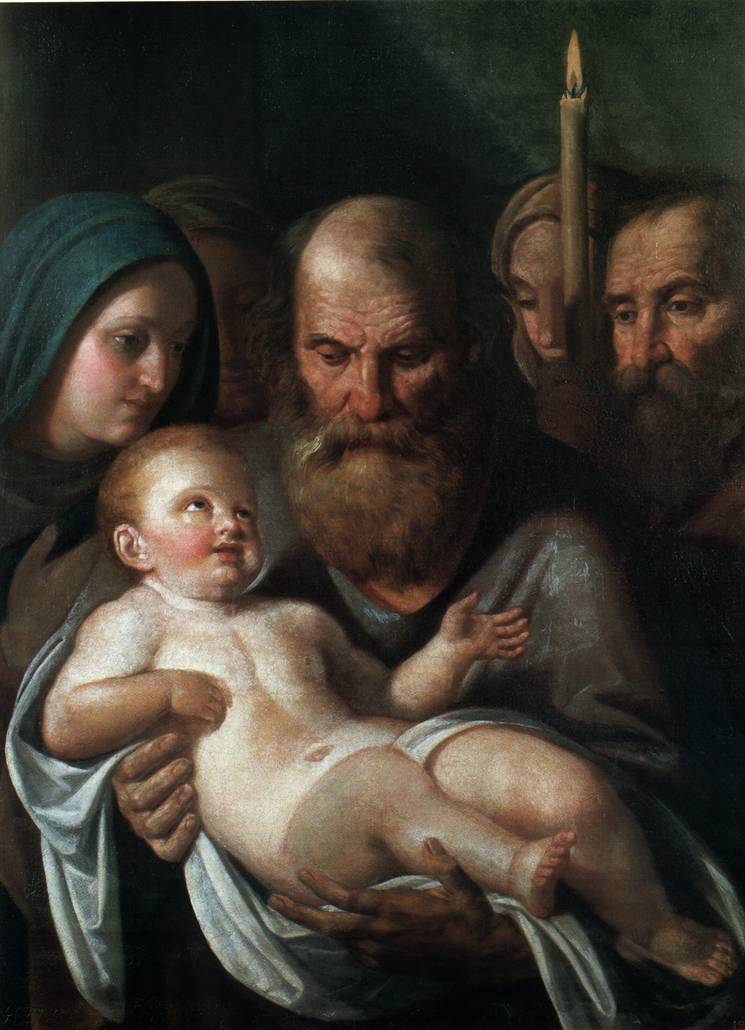
 See
See  (See also
(See also  In last year’s
In last year’s 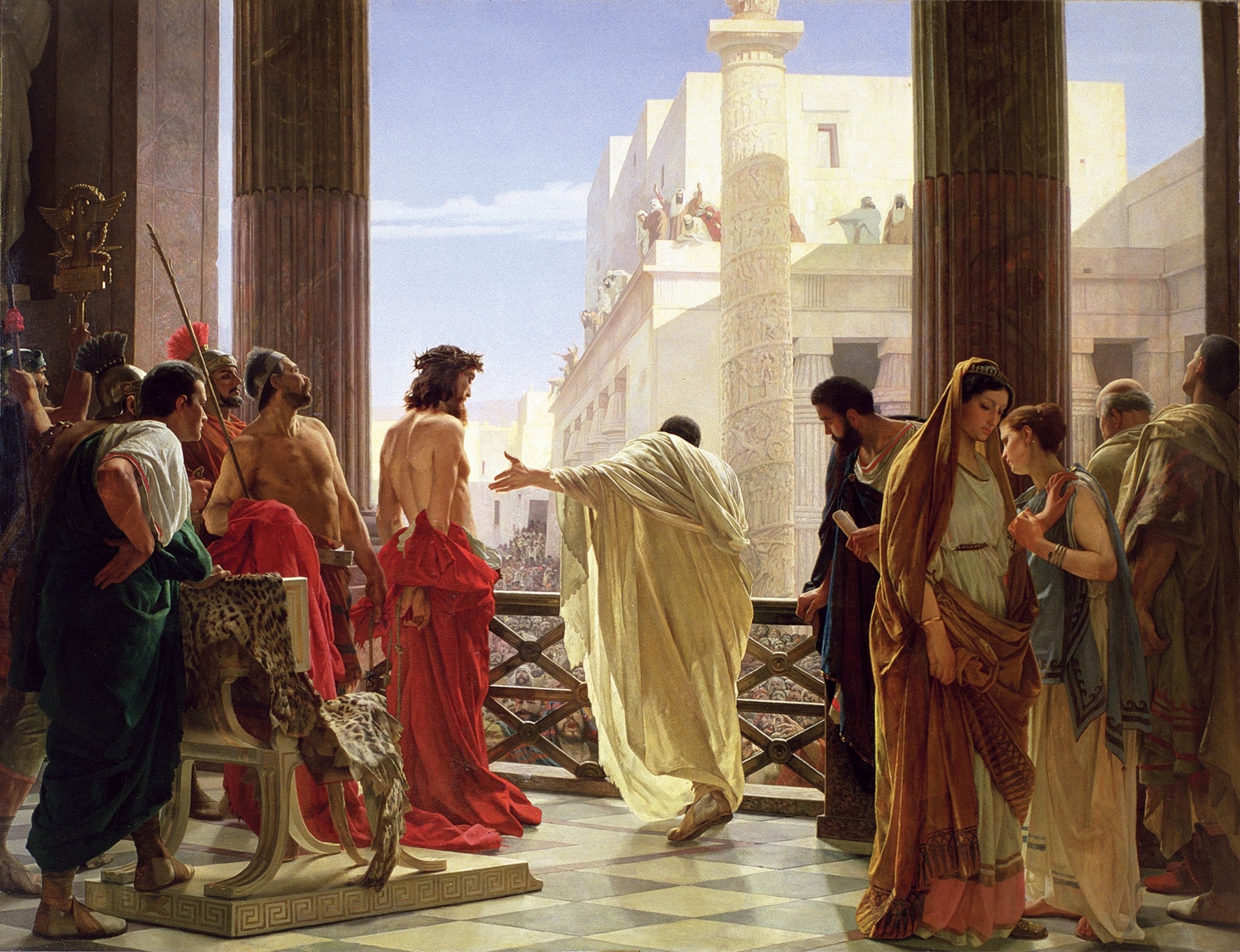

 But first note the word “doctor” used here comes from the Latin
But first note the word “doctor” used here comes from the Latin  Thomas Aquinas changed things up. He “modernized” things.
Thomas Aquinas changed things up. He “modernized” things.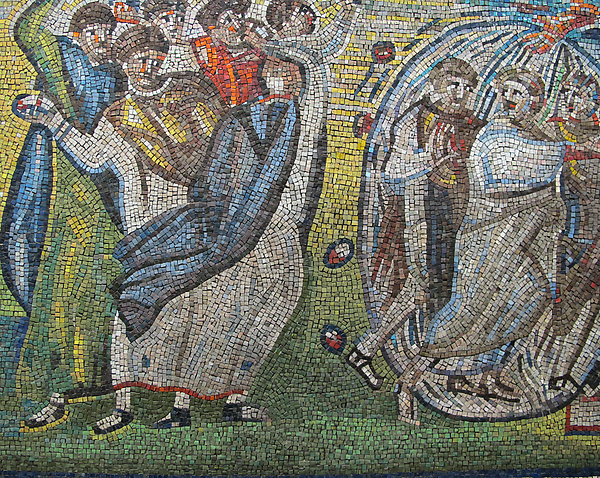 Put another way, there were two initial reactions. Some people rejected the Bible and adopted the philosophy of Aristotle “
Put another way, there were two initial reactions. Some people rejected the Bible and adopted the philosophy of Aristotle “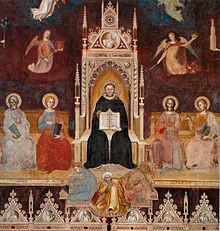 Which is another way of saying such views are
Which is another way of saying such views are 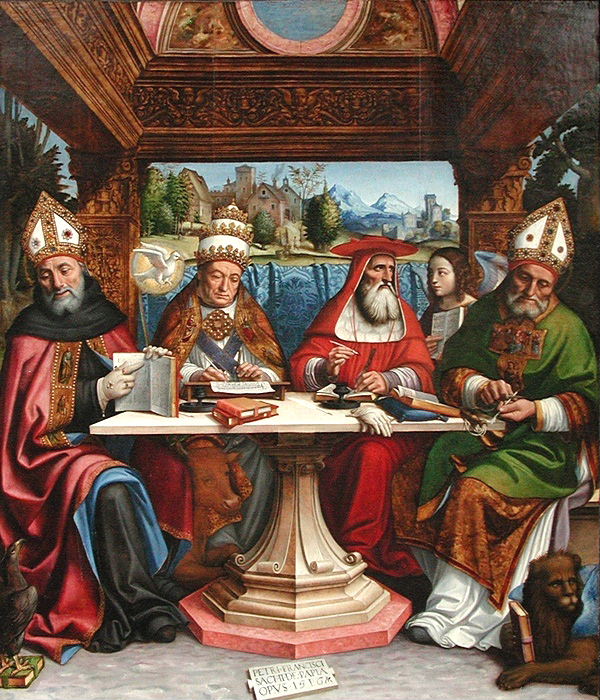

 (That’s where the “relics” came in, in the post title. In turn, the image at right – from that June 25 post – shows “
(That’s where the “relics” came in, in the post title. In turn, the image at right – from that June 25 post – shows “ And they scoff because Moses didn’t tell his audience that the earth was some billions of years old by that time. Or that there’d been “
And they scoff because Moses didn’t tell his audience that the earth was some billions of years old by that time. Or that there’d been “

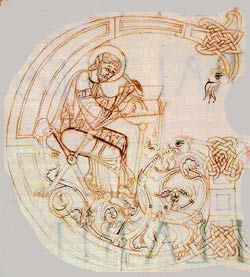 In this case,
In this case, 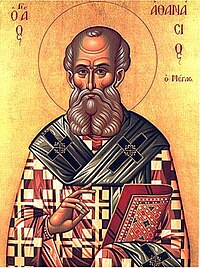 The problem was that Hilary served as bishop at the time of a great early-church conflict: The one pitting
The problem was that Hilary served as bishop at the time of a great early-church conflict: The one pitting  And contrary to the popular assertion that Roman emperor
And contrary to the popular assertion that Roman emperor  On the other hand, Hilary put his four years in exile to good use. He honed his arguments so well that they ultimately acquired the force of (church) law. In essence he was a “Great Dissenter” over 1,500 years before Supreme Court justice
On the other hand, Hilary put his four years in exile to good use. He honed his arguments so well that they ultimately acquired the force of (church) law. In essence he was a “Great Dissenter” over 1,500 years before Supreme Court justice 


 Unfortunately, this news scared the stuffing out of
Unfortunately, this news scared the stuffing out of  The reason for such a practice was given in
The reason for such a practice was given in  The
The 
 But getting back to
But getting back to 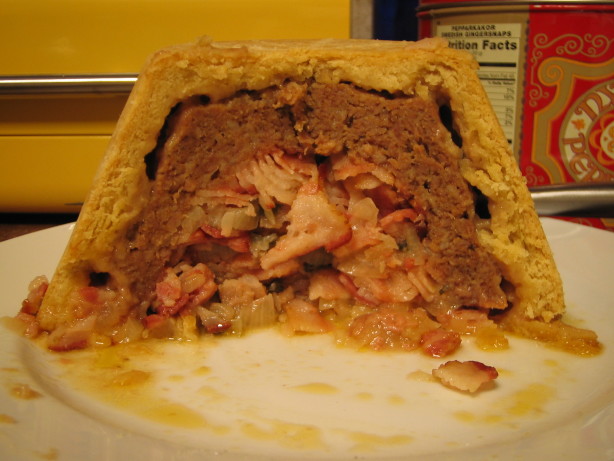 And finally, people usually celebrated Plough Monday by eating
And finally, people usually celebrated Plough Monday by eating 
 That’s another way of saying that exploring the mystical side of the Bible can help you “be all that you can be.” On that note see
That’s another way of saying that exploring the mystical side of the Bible can help you “be all that you can be.” On that note see 
 So here’s the
So here’s the 

 About the same time I did
About the same time I did  “Twelfth Night (The King Drinks)…”
“Twelfth Night (The King Drinks)…”